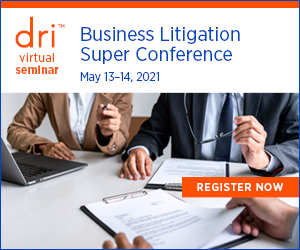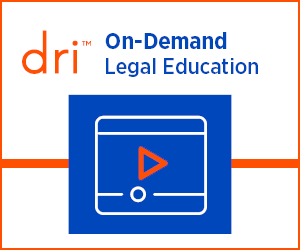Hubbard and the Learned Intermediary Doctrine
The learned intermediary doctrine on which Hubbard relies was established by the Georgia Supreme Court in 2003 with McCombs v. Synthes (U.S.A.), 587 S.E.2d 594 (Ga. 2003). McCombs established that, “under the learned intermediary doctrine, the manufacturer of a prescription drug or medical device does not have a duty to warn the patient of the dangers involved with the product, but instead has a duty to warn the patient’s doctor.” Id. at 594 (emphasis added). The rationale for this doctrine is that “the treating physician is in a better position to warn the patient than the manufacturer, in that the decision to employ prescription medication involves professional assessment of medical risks in light of the physician’s knowledge and the patient’s particular need and susceptibilities.” Id. Courts interpreting Georgia’s learned intermediary doctrine consistently refer to McCombs for this standard, including Hubbard. Hubbard v. Bayer HealthCare Pharms. Inc., 983 F.3d 1223, 1231 (11th Cir. 2020).
The Hubbard case originated in the Northern District of Georgia before it was appealed to the Eleventh Circuit. Hubbard v. Bayer HealthCare Pharms. Inc., 407 F. Supp. 3d 1317 (N.D. Ga. 2019). Plaintiff Karen Hubbard tragically suffered a severe stroke, which left her paralyzed and her cognitive functions severely impaired. 983 F.3d at 1225. Ms. Hubbard claimed that the cause of her stroke was the oral contraceptive drug she was taking, Beyaz. Id. Since the 1960s, the medical community has been aware that certain oral contraceptive drugs are associated with an increased risk of blood clots. Id.
Defendant Bayer moved for summary judgment on the plaintiff’s claim for failure to warn, arguing that Karen Hubbard’s prescribing physician, Dr. Rowley, “had actual knowledge of the risks,” and that he provided “explicit, uncontroverted testimony that he was aware of the potentially higher risk of VTE [blood clots]…long before he wrote Karen Hubbard’s final prescription.” Id. The Hubbards countered with two arguments: first, that the warnings available to Dr. Rowley in December 2011 were inadequate and lacked information made available in the 2012 label update, and second, that Dr. Rowley’s testimony on his December 2011 knowledge of the increased VTE risk associated with the drug was “equivocal.” Id. The Northern District of Georgia ruled in favor of Defendant, determining that Dr. Rowley’s testimony established “that no different warning would have changed the prescribing decision and avoided the injury.” Id.
The Eleventh Circuit reviewed the facts de novo and affirmed the District Court’s conclusion. Id. at 1232. Though proximate cause is an issue of fact normally reserved for a jury, Georgia law provides that a court may decide proximate cause questions as a matter of law “if the evidence is plain and undisputed.” Id. The court determined that Dr. Rowley “provided explicit, uncontroverted testimony that, even when provided with the most current research and FDA mandated warnings, he still would have prescribed the drug to Karen Hubbard.” Id. at 1233.
Dr. Rowley’s testimony stated, in relevant part:
Q: Okay. I believe you said you recall that there may have been a new label issued sometime in 2012…when that happened, did you alert your patients?
A: No.
Q: Why not?
A: Once again, the relative risk that was discussed was actually very small versus the fact that people have been on it for—have taken it, they’re happy with it, that they have not had any complications with it.
Id.
Dr. Rowley testified that he did not change the way he prescribed birth control to patients after April 2012. Id. Further, and most notably, he testified that he would have prescribed Beyaz to Karen Hubbard in December 2011 even if he had the 2012 Beyaz label in hand.
Hubbard is most notable because it solidifies that a plaintiff claiming a manufacturer’s warning was inadequate bears the burden of establishing that an improved warning would have caused her doctor not to prescribe her the drug. The case further reaffirms that the learned intermediary doctrine provides the duty to warn runs to the prescribing physician only, and that if the physician would not have changed his or her prescribing decisions with a different warning, Plaintiff cannot prove proximate cause.
Since Hubbard was decided in late 2020, District Courts have already turned to its guidance. In Swintelski v. Am. Med. Sys., Inc., No. 20-60410-CIV-CANNON/Hunt, 2021 WL 687202 (S.D. Fla. Feb. 22, 2021), the plaintiff underwent a procedure implanting a pelvic mesh product called SPARC Mesh Sling and brought a claim against her surgeon for failure to warn. Id. at *1. The implanting physician, Dr. Kahn, provided persuasive testimony affirming that he would have still prescribed and used the device even if he had been in possession of more detailed warnings about elevated risks. Id. at *5. He stated that his decision to implant the product was the “right thing to do,” that the product was a “good product,” that the operation is a “great operation” that he continues to perform with only occasional minor complications, and, most importantly, that knowing what he knows today, he would have persisted in his decision to prescribe the use of the device in the patient’s operation. Id. at *4.
The court determined that the prescribing physician’s testimony defeated the plaintiff’s argument of proximate causation under failure to warn. The court relied on Hubbard for this conclusion, stating that:
the critical inquiry is not whether Dr. Kahn would have communicated more information to his patient who then perhaps would have altered her decision to undergo surgery. Instead, the relevant question is whether the additional risk information would have impacted the implanting physician’s decision to implant the product at issue.
Id.
This case and its progeny demonstrates that it is vitally important for defendant manufacturing companies seeking summary judgment on failure to warn to obtain very clear, unequivocal testimony that the prescribing physician would have made the same prescribing decision even given an updated warning.
Other Jurisdictions Adopting the Same Hubbard Principles
Hubbard is just one of many recent decisions across the United States to adopt and solidify the learned intermediary doctrine and the physician testimony required for a defendant to rely upon the doctrine to defeat a failure to warn claim. In 2014, the Ninth Circuit, applying Washington law, also affirmed summary judgment on the basis of the learned intermediary doctrine in Luttrell v. Novartis Pharms. Corp., 555 F. App’x 710 (9th Cir. 2014). The decision affirmed that “the learned intermediary doctrine requires a showing that the prescribing physician, not the patient, would have taken a different course of action if better warnings had been issued.” Id. at 710.
Numerous district courts have also recently affirmed the principle and discussed the physician testimony required for a plaintiff to prove causation for failure to warn. In In re Avandia Mktg., Sales Practices & Prods. Liab. Litig., the court denied summary judgment because the prescribing physician did not testify that a different warning from a drug manufacturer would have altered his decision to prescribe the drug for the patient, similarly to Hubbard. 2015 WL 1383070, at *3 (E.D. Penn. Mar. 24, 2015). A recent case in the District of New Mexico, Nowell v. Medtronic Inc., cites to numerous other district courts that consistently determined that “a prescription-drug manufacturer’s alleged failure to warn a prescribing physician cannot be the proximate cause of injury unless the plaintiff can establish that a different warning would have changed the physician’s decision to prescribe the drug, i.e., that, but for the alleged inadequate warning, the physician would not have prescribed the product.” 372 F. Supp. 3d 1166, 1234 (D.N.M. 2019), citing Willett v. Baxter Int’l, Inc., 929 F.2d 1094, 1099 (5th Cir. 1991); Odom v. G.D. Searle & Co., 979 F.2d 1001, 1003-04 (4th Cir. 1992) (upholding summary judgment where the prescribing physician testified that a different warning would not have changed his decision to prescribe an intrauterine device); Plummer v. Lederle Labs., 819 F.2d 349, 358 (2d Cir. 1987) (holding that there was no proximate cause in absence of evidence that different warning would have caused physician to act differently); Fisher v. Bristol-Myers Squibb Co., 181 F.R.D. 365, 370 (N.D. Ill. 1998) (“In a prescription drug failure-to-warn case, the plaintiff must establish that an adequate warning would have convinced the treating physician not to prescribe the product for the plaintiff.”) (internal quotation marks omitted); In re Norplant Contraceptive Prods. Liab. Litig., 955 F. Supp. 700, 710 (E.D. Tex. 1997) (stating that the plaintiffs have the burden of proving that a different warning would have changed the decision of the prescribing physician); Krasnopolsky v. Warner-Lambert Co., 799 F. Supp. 1342, 1347 (E.D.N.Y. 1992) (noting that any alleged inadequacy of the manufacturer’s warning was not, as a matter of law, the proximate cause of the plaintiff’s injuries where the physician testified he would have prescribed the drug even if the warnings had been different); Windham v. Wyeth Lab., Inc., 786 F. Supp. 607, 612 (S.D. Miss. 1992) (granting summary judgment on failure-to-warn claim where the prescribing physician testified that he still would have prescribed a medication even if he had received additional information.).
The principles from Hubbard have been adopted across the country, and thus its lessons are widely applicable.
Implementing the Hubbard Principles During Deposition of the Prescribing Physician
As demonstrated by the court’s focus on this issue in Hubbard, the testimony of the prescribing physician is of utmost importance in cutting off proximate causation for a failure to warn claim. The substance and format of the prescribing physician’s deposition testimony is the bedrock foundation of a motion for summary judgment on a plaintiff’s claim for failure to warn. A well thought-out and executed deposition can not only springboard a piercing cross-examination at trial, but also create the foundation needed for a successful motion. So how can defense counsel ensure that the deposition testimony they will need for their motion for summary judgment is obtained?
First, Hubbard provides excellent guidance on the type of admissions defense counsel should seek from the prescribing physician during the deposition. As explained earlier in this article, in Hubbard, the Eleventh Circuit focused on the prescribing physician’s testimony that, “even now that he kn[ew] exactly what was included” in the later updated label to the pharmaceutical he prescribed, the physician stood by his decision to prescribe the medication:
Lawyer: Do you believe today that your decision to prescribe Beyaz for Mrs. Hubbard was appropriate?
Prescribing doctor: Yes.
Hubbard, 983 F.3d at 1233 (11th Cir. 2020). Other questions to help close out this topic may be:
(1) “Do you stand by your decision today to prescribe [insert treatment] to plaintiff?”;
(2) “Now that you are aware of the new information included on the warning label for [insert pharmaceutical or medical device product], would you still prescribe that treatment to plaintiff?”; or
(3) “You’ve been asked a lot of questions today about various different warnings and risks by plaintiff’s counsel. Sitting here today, taking into account all of the warnings and risks mentioned by counsel, would you still choose to prescribe the [insert pharmaceutical or medical device product] to plaintiff?”
By securing testimony from the prescribing physician that he or she stands by his or her decision to prescribe the treatment, even with knowledge of an updated warning label or new risks that the plaintiff asserts should have been included in an adequate label, defense counsel can create a solid record upon which a Hubbard-focused motion for summary judgment can be based.
Second, the plaintiff’s argument in Hubbard identifies common techniques and strategies plaintiffs’ counsel use to try and obtain admissions to avoid summary judgment. However, when looked at closely, these strategies and arguments are truly red herrings that should not be able to defeat Hubbard’s clear guidance as to what testimony from the prescribing physician is needed to win summary judgment. For example, in Hubbard, the plaintiff argued that, because the prescribing physician changed the way he counseled patients after the label to the pharmaceutical was changed, this was enough to overcome summary judgment. 983 F.3d at 1236. This same tactic was used by the plaintiff in Swintelski. 2021 WL 687202, at *1. The plaintiff pointed to the prescribing physician’s “testimony that he would have communicated additional risk information to his patients about the product had he received such additional information”:
Lawyer: [I]f that information had been made available to you back in 2012, certainly, you would have relayed that to your patients at that time....?
Doctor: Yes, I think that goes without saying. The more information the doctor has to pass on to a patient, the more likely he is to pass it on.
Id. at *4.
But as the Hubbard court made clear, this fact does not overcome summary judgment as “a change in communication practices says nothing about the [updated] label’s impact on [the prescribing physician’s] decisionmaking regarding whether to prescribe.” Hubbard, 983 F.3d at 1236 (emphasis in original). Citing Hubbard, the Swintelski court agreed, and found that a change in communication behavior by the prescribing physician did not defeat summary judgment if that same physician testified that he would still prescribe the treatment at issue. 2021 WL 687202, at *5.
Defense counsel should be aware of these tactics and listen for these types of questions to be asked by plaintiffs’ counsel during the deposition of the prescribing physician. If such questions are asked, defense counsel should follow up with questions to rebut, such as: (1) “Doctor, even if you may have communicated information differently to patients in light of the updated label, do you still stand by your decision today to prescribe the [insert treatment]?”; (2) “Although you may have changed the way you discuss the [insert treatment] with plaintiff, would you still have prescribed [insert treatment]?” By following up with these types of questions, defense counsel can shore up the prescribing physician’s testimony in preparation for arguments against summary judgment like the ones made by the plaintiffs in Hubbard and Swintelski.
By implementing the winning strategies identified in Hubbard, and by preparing to rebut against the plaintiffs’ usual tactics, defense counsel can ensure that the prescribing physician’s deposition testimony is strong evidence for the granting of summary judgment.
 Brett A. Tarver is a health sciences associate in the Atlanta office of Troutman Pepper Hamilton Sanders, LLP. Her practice focuses on the defense of pharmaceutical and medical device manufacturers in products liability litigation. She has served as trial counsel in numerous cases to verdict from Massachusetts to the U.S. Virgin Islands, and is regarded as an up-and-coming trial lawyer in the defense of products. Brett is currently the Second Vice Chair of the Young Lawyers Committee, and is an active member of the Drug and Medical Device and Product Liability Committees.
Brett A. Tarver is a health sciences associate in the Atlanta office of Troutman Pepper Hamilton Sanders, LLP. Her practice focuses on the defense of pharmaceutical and medical device manufacturers in products liability litigation. She has served as trial counsel in numerous cases to verdict from Massachusetts to the U.S. Virgin Islands, and is regarded as an up-and-coming trial lawyer in the defense of products. Brett is currently the Second Vice Chair of the Young Lawyers Committee, and is an active member of the Drug and Medical Device and Product Liability Committees.
 Alex Lilly is an associate in Troutman Pepper’s Atlanta office in the Health Sciences litigation practice group. Her practice focuses on product liability litigation, specifically defending medical device manufacturers. Alex currently serves as the Vice Chair of Membership for the DRI Young Lawyers Committee.
Alex Lilly is an associate in Troutman Pepper’s Atlanta office in the Health Sciences litigation practice group. Her practice focuses on product liability litigation, specifically defending medical device manufacturers. Alex currently serves as the Vice Chair of Membership for the DRI Young Lawyers Committee.
 Gail Rodgers is a partner in the New York City office of DLA Piper. She concentrates her practice in pharmaceutical and medical device litigation, mass torts and government and internal investigations. Gail represents clients on a wide variety of compliance matters, including the Foreign Corrupt Practices Act (FCPA) as well as advising and enhancing compliance programs in response to investigations. Gail has extensive experience in a wide variety of state and federal litigation, including providing strategic advice at each stage of litigation, managing national discovery teams, and implementation of national resolution programs. Gail serves as the Chair of the DRI Drug and Medical Device Committee.
Gail Rodgers is a partner in the New York City office of DLA Piper. She concentrates her practice in pharmaceutical and medical device litigation, mass torts and government and internal investigations. Gail represents clients on a wide variety of compliance matters, including the Foreign Corrupt Practices Act (FCPA) as well as advising and enhancing compliance programs in response to investigations. Gail has extensive experience in a wide variety of state and federal litigation, including providing strategic advice at each stage of litigation, managing national discovery teams, and implementation of national resolution programs. Gail serves as the Chair of the DRI Drug and Medical Device Committee. 


















